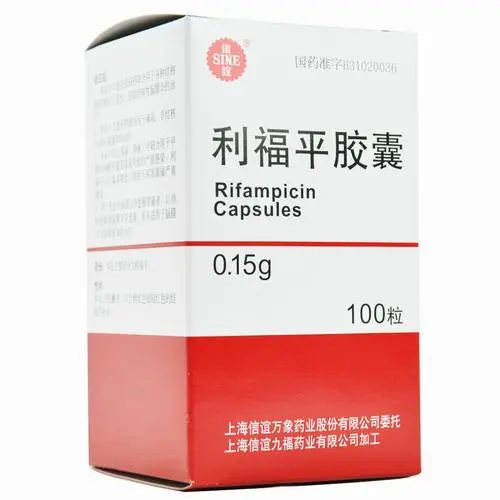Rifampicin Capsules
Effects and efficacy:
Combined with other anti-tuberculosis drugs for the initial and retreatment of various tuberculosis diseases, including the treatment of tuberculous meningitis. Used for asymptomatic carriers of Neisseria meningitidis to eliminate Neisseria meningitidis in the nasopharynx. Combined with other drugs for the treatment of leprosy and non-tuberculous mycobacterial infections. Combined with vancomycin (intravenous) for severe infections caused by methicillin-resistant Staphylococcus. Combined with erythromycin for severe Legionella infections. Rifampicin eye drops can be used for trachoma, conjunctivitis, keratitis, etc. Rifampicin cream can be used for superficial bacterial skin infections (such as impetigo, furunculosis), nasal mucosa inflammation, mild burns (first degree or superficial second degree), scalds, etc.
Dosage and Administration:
Adults with tuberculosis: Oral administration, 450-600mg or 10mg/kg per day, taken on an empty stomach, the maximum daily dose is 1200mg; intravenous drip, 600mg or 10mg/kg once a day, the maximum daily dose is 600mg. Please follow your doctor’s advice for details. Prevention of tuberculosis: Oral administration, 10mg/kg per day, taken on an empty stomach. The maximum daily dose is 600mg. Please follow your doctor’s advice for details. Asymptomatic carriers of Neisseria meningitidis: Oral administration, 300mg or 5mg/kg once, once every 12 hours, for 2 consecutive days. Please follow your doctor’s advice for details. Leprosy: Oral administration, 600mg once a day, 1-2 times a month; or 450mg once a day, taken before meals. The dose should be adjusted according to age or symptoms. Please follow your doctor’s advice for details. Nontuberculous mycobacterium infection: Oral administration, 450mg once a day. The maximum daily dose is 600mg. Please follow the doctor’s advice for details. Legionella or severe staphylococcal infection: intravenous drip, 600-1200mg a day, divided into 2-4 doses. Please follow the doctor’s advice for details. Trachoma, conjunctivitis, keratitis: eye drops administered through the eyes, 1-2 drops at a time, 4-6 times a day. Please follow the doctor’s advice for details. Latent bacterial skin infection, nasal mucositis, mild burns, scalds: cream for local external use, apply or apply to the affected area, 2-3 times a day. Please follow the doctor’s advice for details. Childhood tuberculosis: oral administration, 10-20mg/kg a day, taken on an empty stomach, the maximum daily dose is 600mg; intravenous drip, 10-20mg/kg a day, once a day, the maximum daily dose is 600mg. Please follow the doctor’s advice for details. Asymptomatic Neisseria meningitidis carriers: oral administration. Children under 1 month old: 5mg/kg a day, once every 12 hours, for 2 consecutive days. Children 1 month and older: 10 mg/kg per day, once every 12 hours, for 2 consecutive days. The maximum daily dose is 600 mg. Prevention of tuberculosis: Oral administration, 10-20 mg/kg per day, taken on an empty stomach. The maximum daily dose is 600 mg. Note: This drug should be used with caution in infants. For children, please use it under the guidance of a doctor and under the supervision of an adult.
Adverse reactions:
Gastrointestinal reactions: Some patients may experience burning sensation in the stomach, upper abdominal pain, anorexia, nausea, vomiting, jaundice, gastrointestinal bloating, cramps, diarrhea, etc. Liver: It may manifest as transient abnormalities in liver function indicators (such as elevated serum bilirubin, alkaline phosphatase, and transaminase); rare hepatitis or shock-like syndrome with liver involvement and abnormal liver function. Hematology: Thrombocytopenia usually occurs during high-dose intermittent therapy, and may also occur during the recovery process of interrupted treatment. It rarely occurs in supervised daily medication therapy. Reversible purpura may occur, which disappears after drug withdrawal; if purpura is continued, cerebral hemorrhage or even death may occur. Leukopenia, hemolytic anemia, and decreased hemoglobin may also occur; rare agranulocytosis and disseminated intravascular coagulation may occur. Central nervous system: It may cause headache, fever, drowsiness, fatigue, ataxia, dizziness, inattention, mental distress, behavioral changes, muscle weakness, limb pain, and numbness. Rare reports of mental illness. Ophthalmology: It may cause visual impairment. Endocrine: It may cause menstrual disorders; occasionally, patients with impaired adrenal cortex function may develop renal insufficiency. Kidney: It may cause increased serum urea and uric acid, and occasionally there are reports of hemolysis, hemoglobinuria, hematuria, interstitial nephritis, acute tubular necrosis, renal insufficiency, and acute renal failure. It usually occurs during the recovery treatment after the intermittent medication or daily medication regimen is interrupted. At present, its mechanism is believed to be a drug-induced allergic reaction, which can be relieved after discontinuation of rifampicin and symptomatic treatment. Skin: Skin reactions are relatively mild and often self-limited, usually manifested as skin flushing and itching (with/without rash), not allergic reactions. Severe skin changes caused by hypersensitivity reactions are rare. Allergic reactions: May manifest as itching, urticaria, rash, pemphigoid reactions, erythema multiforme including Stevens-Johnson syndrome, toxic epidermal necrolysis, vasculitis, oral ulcers, glossal pain, conjunctivitis, and drug reactions with eosinophilia and systemic symptom syndrome. Reports of allergic reactions are relatively rare. Other adverse reactions: tooth discoloration (possibly permanent), edema of the face and limbs, and rare reports of muscle lesions. Other reactions to intermittent therapy include flu-like syndrome (fever, chills, headache, dizziness, bone pain, etc.), shortness of breath, asthma, hypotension, and shock. Note: “Flu-like syndrome” may also occur when patients take medication irregularly, so be vigilant.
Drug contraindications:
Allergic to this product is prohibited. It is prohibited during pregnancy. Use with caution during lactation.
Share:
Products
Our offers
Health Classification
Let us work together to protect precious health






























